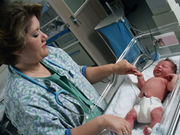Goal is to distinguish between bacterial, viral illness, researchers say
WEDNESDAY, Aug. 24, 2016 (HealthDay News) — A quick genetic test might one day help doctors determine within hours whether an infant’s fever is from a virus or a serious bacterial infection, according to two studies published in the Aug. 23/30 issue of the Journal of the American Medical Association.
Michael Levin, M.D., a professor of pediatrics and international child health at Imperial College London, and colleagues studied 240 children, half of them 19 months old or younger. Fifty-two had an obvious bacterial infection, 92 had a definite viral infection, and 96 had an indeterminate infection.
Levin’s team utilized RNA expression data to identify genes that distinguished bacterial from viral infection. The gene signature also distinguished bacterial infection from childhood inflammatory diseases such as lupus erythematosus and juvenile idiopathic arthritis, the researchers said. Of those 96 undetermined infections, less than half were classified as having bacterial infection, but nearly all received antibiotic treatment.
In another study published in the same journal issue, Octavio Ramilo, M.D., an infectious disease specialist at Nationwide Children’s Hospital in Columbus, Ohio, and colleagues also studied gene biosignatures in infants with fevers at age 2 months or younger. His team examined genes in 279 febrile infants (89 with bacterial infections, 190 without bacterial infections) and 19 healthy infants without fever. The researchers said they identified 66 genes that distinguished infants with and without bacterial infections. Ramilo told HealthDay that their goal is to narrow the number of genes needed to identify bacterial versus viral infections and then develop a quick, inexpensive test.
Abstract 1
Full Text (subscription or payment may be required)
Abstract 2
Full Text (subscription or payment may be required)
Editorial (subscription or payment may be required)
Copyright © 2016 HealthDay. All rights reserved.








